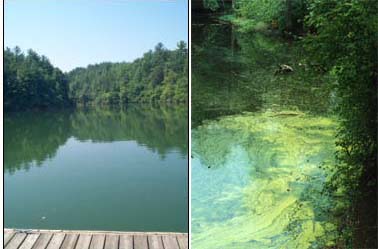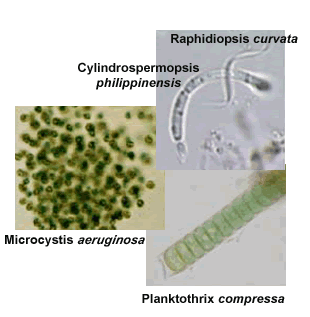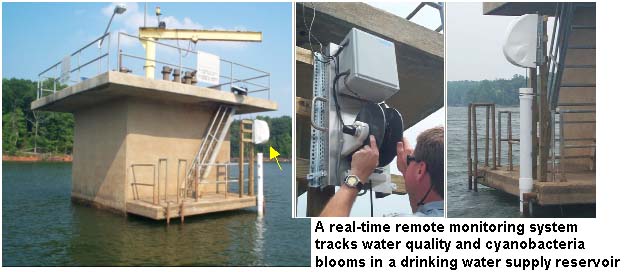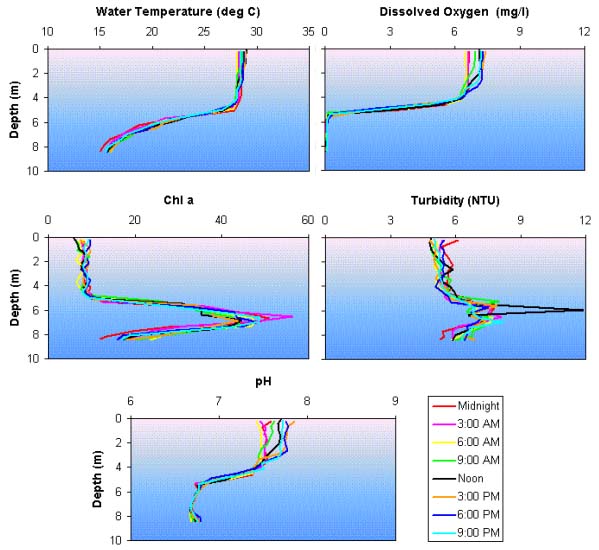Research in Freshwater Ecosystems- Environmental Conditions and Cyanobacteria

NC drinking water reservoir (left) and a cyanobacteria bloom (right)
From the mountains to the coast, the quality of North Carolina’s major potable water supplies is increasingly pressured by impacts from expanding population growth. Many potable water supply reservoirs are adversely affected by sediment loading from development and soil erosion in the watershed. The sediments carry potentially harmful microorganisms, as well as pollutants such as pesticides and nutrients that can stimulate noxious or toxic cyanobacteria blooms.
Cyanobacteria (blue-green algae) are ancient, primitive organisms that are given credit for oxygenating the Earth’s atmosphere. They are nutrient-loving, and often rapidly overgrow slowly flowing waters in rivers and run-of-river impoundments (reservoirs) that receive too much nutrient loading from sewage, lawn and cropland fertilizer runoff, and other sources.
Although cyanobacteria use photosynthesis to produce oxygen during the day, they use oxygen at night in respiration. The often-high densities of cyanobacteria in nutrient-polluted freshwaters (millions to even billions of tiny cells within a teaspoon-volume of water) can rapidly consume all of the available oxygen so that fish die of oxygen deprivation. Some species of cyanobacteria also produce potent toxins that can adversely impact other aquatic organisms as well as humans who recreate in (via water contact) or drink the affected waters.
 CAAE researchers have examined environmental conditions in 28 reservoirs across North Carolina, with emphasis on cyanobacteria species composition, abundance, and toxin production, particularly the toxin microcystin-LR. In addition, strains (populations) of the toxigenic species Cylindrospermopsis raciborskii, have been isolated, cloned, and tested for toxin production.
CAAE researchers have examined environmental conditions in 28 reservoirs across North Carolina, with emphasis on cyanobacteria species composition, abundance, and toxin production, particularly the toxin microcystin-LR. In addition, strains (populations) of the toxigenic species Cylindrospermopsis raciborskii, have been isolated, cloned, and tested for toxin production.
The sampled North Carolina reservoirs are nutrient over-enriched (median concentrations ~41 µg total phosphorus per liter, ~740 µg total nitrogen per liter, and ~21 µg chlorophyll a per liter, 2002-2004 data). In the 2002 growing season, Cyanobacteria comprised ~60-95% of the total phytoplankton by cell number, and >90% of the total phytoplankton cells in most of the reservoirs. These data likely underestimate the abundance of cyanobacteria under optimal growing conditions, considering that two of the three years sampled thus far were “wet summer” years with high precipitation that does not favor cyanobacteria growth.
The toxin microcystin-LR has been detected at less than or equal to 0.6 µg/L in most water samples. Microcystin-LR concentrations have been positively correlated with both total phosphorus and total nitrogen concentrations in newer reservoirs (20-30 years post-fill), and with total phosphorus concentrations in older reservoirs (60-80 years post-fill).

Ongoing, rapid watershed development in North Carolina is expected to increase nutrient loading and cyanobacteria blooms in many of the State’s reservoirs, including toxic species and strains. Real-time remote monitoring systems are being installed in several major drinking water supply reservoirs to intensively track water quality conditions and provide “early warning” capability in detecting developing blooms. Sampling is also planned for certain pollutants and additional microorganisms that can cause human health problems. The data will help protect our State’s drinking water supplies.

Example of data from a RTRM station on a major drinking water supply reservoir
in the Research Triangle area (24-hour period)
